The great Norman Robinson passed away on July 31, 2025. He was 88 years old. He and Stan Schmidt pioneered South African Shotokan karate from 1963, but he was already a major wrestler and judoka, a member of the redoubtable Robinson fighting family. I wish to make some personal observations about my relationship with him.
During my time in the SAJKA between 1978 and 1995, I didn’t have much direct interaction with Norman. Stan Schmidt and Keith Geyer were my primary instructors, more so Keith from the mid-80s, so I saw Norman mainly at tournaments, gradings, and the rare occasions when I attended interdojo training at his Randburg dojo. He knew me by name and was always welcoming.
In 1983, at 23 years old, I participated in the SAJKA’s trip to Japan for its 20th anniversary. One morning, while waiting for the general class to begin at the JKA’s Ebisu headquarters, Norman summoned me for some kumite. Of course, I was terrified and hopelessly outclassed. I knew from experience that social distancing took on new meaning when a karateka like Norman invited you for a fight. But I tried what I could, even catching him ever so lightly on the ear with a bluff mae geri-mawashi geri that earned me only that big Norman smile—there was zero retaliation. Then, in 1987, at the national seminar in Muizenberg, while we were hanging around waiting for the proceedings to start, Norman approached me, smiling expansively, and rubbed his hands together. “Payday today!” We both erupted with laughter because we knew what he meant, but he never laid a hand on me. I never once heard of this consummate martial artist intentionally hurting or bullying any junior.
I lived abroad for just over two and a half decades but used to visit Johannesburg regularly. In 2014, I ran into Clive Strugnell, one of Norman’s beloved students and friends, who insisted I join in a training session at Norman’s dojo. He didn’t immediately recognize me considering the passage of perhaps fifteen years since I had last seen him, but it all came back to him over post-training coffee.
In 2020, to escape COVID that was moving quickly from Italy into France, where I lived, I decided to return home. The universe arranged a chance encounter in 2021 with Albert Janse, one of Norman’s best students in the ’70s and ’80s. As with Norman, I knew Albert peripherally in the SAJKA. He insisted that he take me to see Norman. I was initially hesitant, unsure of how he might receive me, but the hesitation evaporated when I met Norman at his home. Just as he had been when I was a youngster in the SAJKA, he was warm and welcoming. We went through a few perfunctory exchanges, and then he went straight in: “Colin, I know about your book, but what about mine? I’ve been trying for ten years to do it, but nobody is available. Now I have you.” What could I say to that?
So began my strong four-year-long friendship with Norman. For the next nine months, I would spend a hundred hours interviewing him, his wife Sally, and several of his students to prepare the manuscript of his memoir. This exercise gave me intimate access to his exceptional life. He shared wide-ranging information and archival material about his childhood and formative years; his parents and siblings; his personal experiences, achievements, endeavours, and relationships; and about his own trials and tribulations. In doing so, he gave me a window into the richness of the Robinsons.
I trained at his dojo a few times, but I had told him I didn’t want to be in organized karate. That was just fine with him. He never pressured me. It was enough that we continued as friends away from the dojo, allowing me to forge a lovely, deeply rewarding relationship with him and Sally. I defer to karateka greater than I in assessing Norman’s stature. But, I like to think that my friendship with him was unusual because I wasn’t his student, so I didn’t have to observe strict karate protocol. Make no mistake. I knew my karate place, but he never leveraged the sempai–kohai thing as the basis for our relationship. I didn’t have to do those stupid SAJKA-era, knee-busting bunny hops or duck walks around the dojo, or sit against the dojo wall in the chair position, knees bent at ninety degrees and arms outstretched, until I collapsed. And I didn’t have to shout osu loud enough until it was audible over twenty miles of open water. He was simply my friend.
We must remember his immutable character. He never bullied anyone, he was fair, he was never nasty or vindictive, he wasn’t an insufferable braggart, and didn’t need to rave untruthfully about himself on Facebook. He was a man of soft heart, bulletproof integrity and honesty, and unbelievable perseverance and courage. He was a towering karate presence whom the Japanese in particular revered for his extraordinary skill. In the end, Norman Robinson did it all his way—with no excuses.
